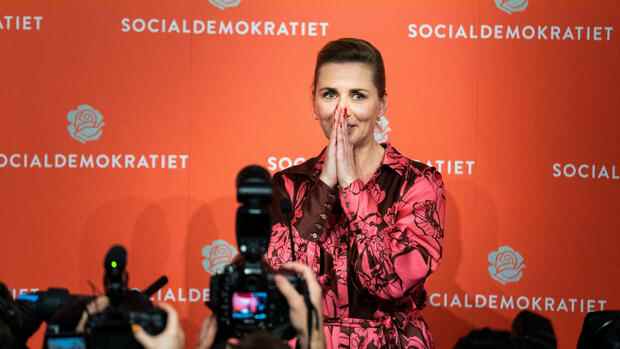Despite the extremely narrow victory, Frederiksen handed in the resignation of her previous minority government on Wednesday morning. She wants to create the basis for the broadest possible government alliance with parties from both political camps. Such a form of government is rare in Denmark – but according to Frederiksen it is exactly the right thing to do in view of the current crises.
Until late at night it was unclear whether this could succeed. But after counting the votes from the Danish regions of Greenland and the Faroe Islands, it was clear that the more left-leaning parties in the red camp had achieved a slim majority. It is expected that Frederiksen will be given the mandate to form a new government, especially as her Social Democrats have become the strongest political force again with 27.5 percent of the vote.
However, it is unclear with which parties the 44-year-old wants to work. During the short election campaign, Frederiksen had emphasized that because of the uncertain geopolitical situation, she was striving for a broad alliance that went beyond the camp borders.
Top jobs of the day
Find the best jobs now and
be notified by email.
So far, she has led a minority government that has sought support from both political camps on individual issues. The social democrat has been repeatedly criticized for this, as she secured the support of the right-wing parties through an extremely restrictive course in asylum policy. Should there actually be a broad governing coalition, that would be a novelty in Danish post-war history. Most Danish governments did not have their own majority.
Dramatic election night
Denmark had previously experienced an eventful election evening. Forecasts and projections had long indicated that neither the red, left-wing camp nor the blue, center-right coalition would win a majority. At the time, the key role between the blocs was held by former Prime Minister Lars Løkke Rasmussen with his new centrist-liberal party, The Moderates.
The liberal politician founded his own party, The Moderates.
(Photo: Reuters)
After counting all the votes cast in the country, the picture tilted to the left at the very last minute: the red block jumped to 87 mandates, while the blue block came to 72, 16 go to Løkke’s moderate. A year ago, he left the liberal-conservative party Venstre, which he led, and founded a new party, Die Moderate.
His party does not belong to either of the two political blocs, Rasmussen had repeatedly emphasized and clearly felt comfortable in the role of tipping the scales. Now that role will presumably fall to the left-liberal Radikale Venstre party, the party that forced the new elections.
The social-liberal party had already threatened to withdraw support from Frederiksen’s government and a vote of no confidence if new elections were not called by October 6th. So Frederiksen had the choice between a vote of no confidence and new elections. She opted for the early election date.
Trouble started during corona pandemic
The little radical Venstre’s anger with the social democratic minority government began during the corona pandemic. In late autumn 2020, Frederiksen decided to have around 15 million mink killed for fear of dangerous virus mutations.
Narrow majority for left camp in parliamentary elections
A mutation that is also dangerous for humans was discovered in the animals. The problem was that there was no legal basis for the killing. The head of government was reprimanded by a parliamentary committee of inquiry, and several state secretaries had to resign.
And Radical Venstre presented Frederiksen with the alternatives: new elections or a vote of no confidence. How the party will position itself now is not yet entirely clear. Both political blocs were still courting the party’s support on election night.
According to most observers, Frederiksen has the best chance of forming a government. Because even if the negotiations with parties in the middle-class camp should fail, she could, as before, seek a majority from her left-wing support parties.
The election campaign was dominated by domestic political issues. Deficits in the healthcare system, low wages in the care sector and high inflation were the central themes. The formation of the new Danish government is expected to take a few weeks.
90 of the 179 seats are necessary for a majority in the Danish parliament in Copenhagen. 175 of these mandates are awarded in Denmark, two each in Greenland and on the Faroe Islands, both of which are officially part of the Kingdom of Denmark.
More: International comparison of locations: Denmark tops the world for the first time – Germany stagnates in 15th place
